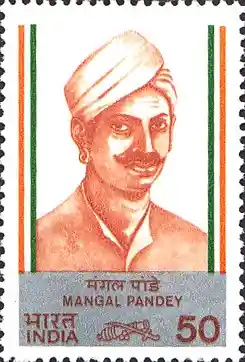The noose which went loose on the British
Just a lowly sepoy in the 34th Bengal Native Infantry (BNI) regiment of the English East India Company, Mangal Pandey was the aflame matchstick to the fiery Indian rebellion of 1857!

Stamp published by Indian Post in his honour; Source: Public Domain
What goes inside the mind of a killer? This is something that has been covered a lot in recent mass media. But what about inside the mind of a freedom fighter, particularly Mangal Pandey?
The 1857 revolt, no matter how it was culled very quickly by the British government, had a seeming effect on the morale of the Indians. They realized they could fight back against their colonizers, who had been cruel masters and had destroyed the mindset of the public in such a way that a miniscule amount of rebellion was subjected to harsh punishment, in the minds of the Indians.
But the revolt of 1857 sparked the kerosene inside the Indians, especially after Mangal Pandey was hanged. This event caused the aftermath of mutinies across India. But what did go through Mangal Pandey himself when he caused the outrage which led to him firing and attacking an English officer?
By now, many Indians know the general gist of the plot. Rumours of a new cartridge whose grease was of cow and pig fat did not sit well at all with the Hindus and the Muslims. Both of their religions held significant ideals of the animals in a polarizing fashion.

Whether this was the cause of Pandey's actions or not, he attacked Lieutenant Baugh and fought with him. Both of them missing their aim, started a melee. Pandey was faster, and so he quickly slashed Baugh through his shoulder. Another sepoy, seeing this, immediately started attempting to restrain him to prevent further damage. The violence continued when another officer joined in the bout with Pandey. The officer was still trying to restrain him but was being stoned for his attempts by his own fellow sepoys. Finally, General Hearsey threatened to shoot anyone who disobeyed his orders to restrain Pandey. The troops gave in and finally, it was over.
Historians have portrayed Mangal Pandey as a mastermind behind the rebellion, but accounts say otherwise. In court, it is said that he himself mentioned he was under Bhang and Opium use, both of which are drugs with harsh mental effects. So was it his rage mixed with a drug that led him to the mutiny?
Mangal Pandey was simply a sepoy who took what every sepoy felt at that time and put it into action. Be it under the influence of a drug or not. Even during his bout with the English officers, several sepoys except one simply stood back and watched.
Why did they not join in? Was it fear? So their fear triumphed their own spirit of freedom? It is something to retrospect.
Later on, even after his death, he was turned into one of the most leading figures in the history of Indian independence but was also subject to propaganda later on. Behind all the violence, it is especially important to understand the motive behind the action.


